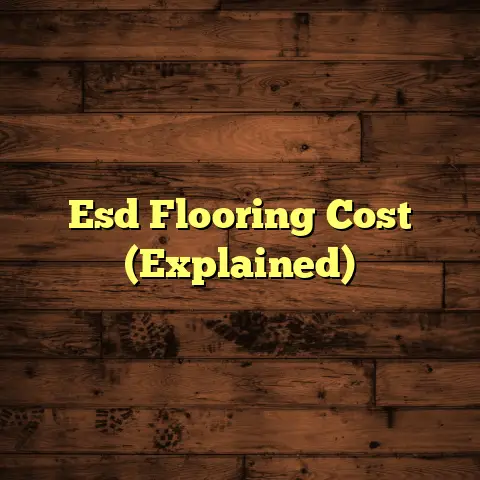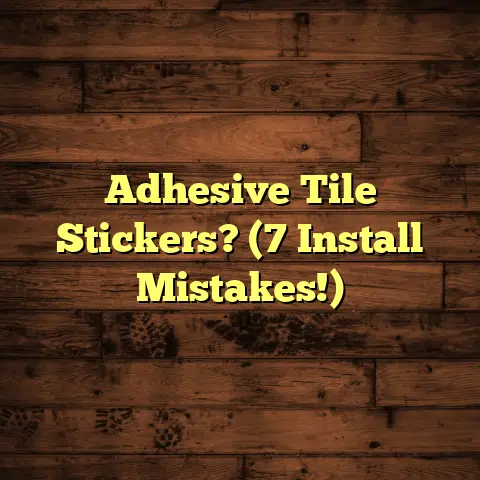Leftover Flooring? (5 Smart DIY Ideas Revealed!)
And let me tell you, I’ve seen a lot of leftover flooring.
It’s practically a rite of passage after any renovation, isn’t it?
But instead of letting those extra planks and tiles gather dust, I’m here to show you how to turn them into something amazing.
We’re talking about breathing new life into discarded materials, saving some serious cash, and adding a personal touch to your home that you just can’t buy in a store.
Flooring is built to last, sometimes for decades.
That’s why repurposing it is such a smart move.
It’s good for your wallet and the planet!
Ready to get started? Let’s dive in!
Section 1: Understanding Your Leftover Flooring
First things first, let’s talk about what you’re working with.
Not all flooring is created equal, and knowing your material is key to a successful DIY project.
Types of Flooring
Think of the flooring world as a diverse ecosystem. We’ve got:
- Hardwood: The king of durability and classic style.
It can handle a beating and looks even better with age. - Laminate: A budget-friendly alternative that mimics the look of hardwood or tile.
It’s relatively easy to work with. - Tile: Perfect for kitchens and bathrooms, tile is water-resistant and incredibly tough.
- Vinyl: Versatile and affordable, vinyl comes in planks, tiles, and sheets.
It’s also waterproof, making it great for various projects. - Engineered Wood: A great alternative to hardwood.
It is more resistant to moisture and temperature fluctuations.
Each type has its own strengths and weaknesses, and those will influence what you can create.
Assessing Quality
Before you get too excited about your DIY dreams, give your leftover flooring a good once-over.
I’ve seen some pretty beat-up leftovers in my day, and sometimes, they’re just not worth salvaging.
Here’s what to look for:
- Wear and Tear: Scratches, dents, and worn edges are common, but excessive damage might make the flooring unsuitable for certain projects.
- Moisture Damage: Water stains, warping, or mold are red flags.
Avoid using flooring with these issues, especially for indoor projects. - Cracks and Chips: These can compromise the structural integrity of the flooring, especially with tile or hardwood.
- Consistent Color and Pattern: Make sure you have enough pieces with a similar color and pattern to create a cohesive look.
If your leftovers are in decent shape, you’re golden!
If not, you might need to adjust your project or source some additional materials.
Section 2: DIY Idea #1 – Unique Wall Art
Time to get creative!
This is one of my favorite ways to use leftover flooring.
It’s simple, impactful, and totally customizable.
Concept
Think beyond boring beige walls!
Use your flooring to create a statement piece that reflects your personal style.
You can make abstract patterns, geometric designs, or even recreate a favorite landscape.
Materials Needed
- Leftover flooring (obviously!)
- Measuring tape
- Pencil
- Saw (circular saw, jigsaw, or hand saw)
- Sandpaper
- Adhesive (construction adhesive or strong glue)
- Backing board (plywood or MDF)
- Frame (optional)
- Varnish or sealant (optional)
- Hanging hardware (hooks, wire)
Step-by-Step Instructions
- Plan Your Design: Sketch out your design on paper.
Consider the size, shape, and color of your flooring pieces. - Measure and Cut: Use your measuring tape and pencil to mark the flooring pieces according to your design.
Cut them carefully with your saw.
Remember to always wear safety glasses and gloves! - Sand the Edges: Smooth out any rough edges with sandpaper.
This will give your artwork a more polished look. - Arrange and Adhere: Arrange the flooring pieces on your backing board to make sure you like the layout.
Once you’re happy, apply adhesive to the back of each piece and press it firmly onto the board. - Let it Dry: Allow the adhesive to dry completely according to the manufacturer’s instructions.
This might take several hours or even overnight. - Frame (Optional): If you want to add a frame, measure your artwork and purchase a frame that fits.
- Finishing Touches: Apply varnish or sealant to protect the artwork and enhance its colors.
- Hang and Enjoy: Attach hanging hardware to the back of the board and hang your masterpiece on the wall!
Finishing Touches
- Experiment with different layouts: Try arranging the flooring pieces in different patterns to see what you like best.
- Add texture: Use different thicknesses of flooring or add other materials like wood scraps or metal accents.
- Consider the color palette: Choose colors that complement your existing décor.
- Protect your artwork: Apply a coat of varnish or sealant to protect it from moisture and UV damage.
Section 3: DIY Idea #2 – Custom Shelves
Who doesn’t need more storage?
These DIY shelves are easy to make, stylish, and perfect for displaying your favorite books, plants, or knick-knacks.
Concept
Floating shelves add a modern, minimalist touch to any room.
Using leftover flooring gives them a unique, rustic charm.
Materials Needed
- Leftover flooring
- Measuring tape
- Pencil
- Saw
- Sandpaper
- Brackets (heavy-duty floating shelf brackets)
- Screws
- Drill
- Level
- Wood stain or paint (optional)
Step-by-Step Instructions
- Measure and Cut: Decide on the length and depth of your shelves.
Measure and cut the flooring pieces to the desired size. - Sand the Edges: Smooth out any rough edges with sandpaper.
- Stain or Paint (Optional): If you want to change the color of the shelves, apply wood stain or paint according to the manufacturer’s instructions.
- Attach the Brackets: Attach the floating shelf brackets to the back of the shelves using screws.
Make sure the brackets are evenly spaced and securely attached. - Install the Shelves: Use a level to mark the desired location for your shelves on the wall.
Drill pilot holes and attach the shelves to the wall using screws. - Test the Stability: Make sure the shelves are level and can support weight before placing anything on them.
Styling Tips
- Mix and match: Combine different types of flooring for a unique look.
- Add plants: Greenery adds a touch of life to any space.
- Create a gallery wall: Arrange multiple shelves together to create a gallery wall.
- Use decorative boxes: Store small items in decorative boxes to keep your shelves organized.
Section 4: DIY Idea #3 – Rustic Furniture
Feeling ambitious?
Let’s tackle some furniture!
This is where you can really show off your DIY skills.
Concept
Turn your leftover flooring into a one-of-a-kind coffee table, bench, or even a headboard.
The possibilities are endless!
Materials Needed
- Leftover flooring
- Measuring tape
- Pencil
- Saw
- Sandpaper
- Wood glue
- Screws
- Drill
- Clamps
- Furniture legs (optional)
- Wood stain or paint (optional)
- Varnish or sealant
Step-by-Step Instructions (Coffee Table)
- Plan Your Design: Decide on the size and shape of your coffee table.
Sketch out your design on paper. - Measure and Cut: Measure and cut the flooring pieces to the desired size.
- Assemble the Tabletop: Apply wood glue to the edges of the flooring pieces and clamp them together to form the tabletop.
Let the glue dry completely. - Sand the Tabletop: Sand the tabletop smooth with sandpaper.
- Attach the Legs (Optional): If you’re using furniture legs, attach them to the underside of the tabletop using screws.
- Stain or Paint (Optional): If you want to change the color of the coffee table, apply wood stain or paint according to the manufacturer’s instructions.
- Apply Finish: Apply varnish or sealant to protect the coffee table from moisture and wear.
Personalization
- Add a metal frame: Create a modern industrial look by adding a metal frame to your furniture.
- Use reclaimed wood: Combine your leftover flooring with reclaimed wood for a rustic, eco-friendly piece.
- Distress the finish: Create a vintage look by distressing the finish with sandpaper or a wire brush.
- Add a mosaic: Create a unique tabletop by arranging small pieces of flooring in a mosaic pattern.
Section 5: DIY Idea #4 – Flooring for Garden Paths
Bring the indoors outside!
This is a great way to add character to your garden and create a functional walkway.
Concept
Use your leftover flooring to create a charming garden path or patio.
This is a sustainable way to recycle materials and add a unique touch to your outdoor space.
Materials Needed
- Leftover flooring (tile, pavers, or treated wood)
- Measuring tape
- Shovel
- Landscape fabric
- Gravel or sand
- Level
- Rubber mallet
- Edging material (optional)
Step-by-Step Instructions
- Plan Your Path: Decide on the layout of your garden path.
Mark the path with stakes and string. - Prepare the Ground: Remove the top layer of soil from the path.
- Lay Landscape Fabric: Cover the path with landscape fabric to prevent weeds from growing.
- Add Gravel or Sand: Pour a layer of gravel or sand over the landscape fabric.
This will provide a stable base for your flooring. - Level the Surface: Use a level to make sure the surface is even.
- Lay the Flooring: Arrange the flooring pieces on the prepared surface.
Use a rubber mallet to tap them into place. - Add Edging (Optional): Add edging material to the sides of the path to keep the flooring in place.
Maintenance Tips
- Clean regularly: Sweep or hose off the path to remove dirt and debris.
- Repair cracks: Fill any cracks or chips with concrete patch or epoxy.
- Seal the flooring: Apply a sealant to protect the flooring from moisture and UV damage.
- Weed control: Regularly remove weeds that grow along the edges of the path.
Section 6: DIY Idea #5 – Creative Pet Projects
Don’t forget your furry friends!
These projects are fun, functional, and will make your pet feel right at home.
Concept
Create a custom pet feeding station, a cozy pet bed, or even a scratching post for your feline friend.
Materials Needed
- Leftover flooring
- Measuring tape
- Pencil
- Saw
- Sandpaper
- Wood glue
- Screws
- Drill
- Bowls (for feeding station)
- Fabric and stuffing (for pet bed)
- Rope or sisal (for scratching post)
Step-by-Step Instructions (Pet Feeding Station)
- Plan Your Design: Decide on the size and shape of your feeding station.
Consider the height of your pet. - Measure and Cut: Measure and cut the flooring pieces to the desired size.
- Cut Bowl Holes: Use a hole saw to cut holes in the tabletop for the bowls.
- Assemble the Feeding Station: Assemble the feeding station using wood glue and screws.
- Sand the Edges: Sand the edges smooth with sandpaper.
- Apply Finish: Apply a pet-safe finish to protect the feeding station from moisture and wear.
Customization
- Personalize with paint: Paint the feeding station with your pet’s name or a fun design.
- Add storage: Add a drawer or shelf to store pet food and supplies.
- Make it adjustable: Create an adjustable feeding station that can be raised or lowered to accommodate your pet’s growth.
- Use non-toxic materials: Make sure all materials used are non-toxic and safe for your pet.
Conclusion
So there you have it! Five smart DIY ideas for using your leftover flooring.
I hope I’ve sparked your imagination and shown you that those extra pieces can be so much more than just clutter.
Remember, the key is to embrace your creativity, think outside the box, and don’t be afraid to experiment.
You might be surprised at what you can create!
Not only will you be saving money and helping the environment, but you’ll also have the satisfaction of knowing that you made something truly unique with your own two hands.
Now go on, get out there and start building!
And don’t forget to share your creations with me.
I can’t wait to see what you come up with!





